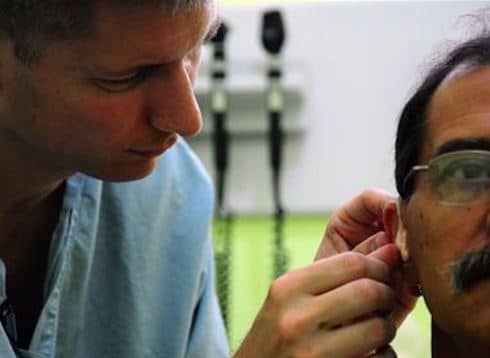Hearing Aid Selection: Consumer vs Hearing Aid Dispenser
This post is directed at answering the question: would a consumer select the same hearing aid signal processing algorithm as was recommended by an audiologist? A signal processing algorithm refers to a completely different type of functioning hearing aid, not just to single hearing aid that allowed the user to select from among different environmental conditions (quiet, noise, listening in a car, music, restaurant, etc.) by pushing a button on the hearing aid, changing the setting using on a smart phone, or by use of a remote control that allowed the same kinds of environmental listening selections.

Figure 1. Patient (subject) hearing aid signal processing preference versus the signal processing algorithm recommended for that subject by eleven different audiologists having access to the same audiometric information and subject history. Of the fourteen subjects, all but one were experienced hearing aid wearers.
A previous post provided an overview of the study results, showing that subject preference for a given signal processing scheme (algorithm) was not the same as that recommended by the audiologist (Figure 1). Additionally, when eleven different audiologists made a signal processing scheme recommendation for the same individual, agreement was not good.
This week’s post looks at the data presented last week in greater detail, because averaged percentage data is not a good indication of the relationship of preferred use versus recommendation.
Will Consumers’ Preference for the Kind of Circuit Change Over Time?
How consistent to a given hearing aid signal processing scheme (algorithm) are hearing aid wearers when given an opportunity to change between different algorithms over time? In this study, when given this opportunity to select between essentially different hearing aid fundamental algorithms, would their preferences change after two weeks to two months?
Hearing Aid Algorithm Rank Order Preferences
Rank order preferences by the subjects for the different algorithms are shown in Figure 2 during the first week (left) versus rank order preferences after two weeks to two months (right). During the first week, seven (50%) subjects ranked the Clarifier algorithm as number 1. Even though the Clarifier algorithm dropped to about 36% after two weeks to two months, it continued to rank as the number 1 algorithm. This was a two-channel BILL (Bass Increases at Low Levels)[1]signal processor fitted according to the NAL-R hearing aid fitting formula.
The algorithm least preferred during the test was the Equalizer algorithm. This was somewhat surprising because this was a four-channel hearing aid that allowed independent programming in each channel, providing the greatest gain adjustment of all the hearing aids in the study, in approximating the gains to the fitting formula (DSL I/O).

Figure 2. Consumer (subject) algorithm preferences during the first week of use (left), versus the consumer algorithm preferences after two weeks to two months (right). Each bar represents the number of subjects who preferred that algorithm.
Hearing Aid Algorithm Percent Usage by Subjects
Although Figures 1 and 2 provide general trends, it is more significant to view how individual subjects ranked the different algorithms from the first week to two weeks to two months. The percentage of time that each subject used the algorithms during this time period is shown in Figure 3.

Figure 3. Individual subject algorithm selections (Fidelity, Comfort, Clarity, Equalizer) during the first week (top) versus preferences at two weeks to two months of the study. Subjects (all but one), were experienced hearing aid wearers, using the hearing aids throughout a normal day.
The data show that four of the subjects (GDR, JGL, AEV, KG, and JR) showed the greatest change in preferences, while seven of the subjects (HB, LJ, WS, JAH, VH, LB, and GR) showed the least preference changes. Regardless, significant preferences changes occurred on an individual basis during the time period of the test.
*This article was originally published at Wayne’s World on November 3, 2015. Title image courtesy USAF
- Killion, M. C., Staab, W. J., and Preves, D. A. Classifying automatic signal processors, Hearing Instruments, Vol. 41, No. 8, 1990↵
 Wayne Staab, PhD, is an internationally recognized authority on hearing aids. His professional career has included University teaching, hearing clinic work, hearing aid company management and sales, and extensive work with engineering in developing and bringing new technology and products to the discipline of hearing. Dr. Staab is the Founding Editor of Wayne’s World and served as the Editor-In-Chief of HHTM from 2015 to 2017.
Wayne Staab, PhD, is an internationally recognized authority on hearing aids. His professional career has included University teaching, hearing clinic work, hearing aid company management and sales, and extensive work with engineering in developing and bringing new technology and products to the discipline of hearing. Dr. Staab is the Founding Editor of Wayne’s World and served as the Editor-In-Chief of HHTM from 2015 to 2017.








The preference of a hearing aid used is directly linked to the changed pattern of dendritic connections that the genes work on to counteract the hearing changes. Once this is completed, within the best abilities of our neurological abilities, then the hearing aid patient will say that he likes the hearing aid.
The goal of every hearing aid is to excite the neurogenesis patterns to deal with hearing degradation. Results vary depending upon the genetic responses.. What I have noticed is that positive motivation plays a key role in the acceptance of the quality of hearing provided by the hearing aid. Hearing aid wearers are mostly negatively motivated due to denial, and trust in the efficacy of hearing technologies.